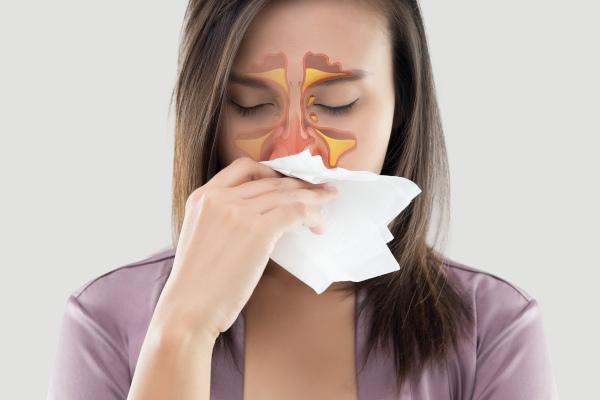THE sinusitis it is an inflammation of the sinuses and can be classified as acute or chronic. Currently, the term rhinosinusitis is adopted, since sinusitis practically does not occur without the occurrence of rhinitis.
Among the symptoms of rhinosinusitis we can mention: a headache in the region of the facial sinus that is more affected and the presence of yellowish or greenish nasal secretion. Fever, cough and muscle pain may also be present.
Viral diseases, dry weather and rainy weather are some of the factors that can trigger the development of rhinosinusitis. The disease has treatment, however, it will depend on its causative agent.
Read more:Diseases caused by viruses - symptoms, treatment and prevention
What is sinusitis?
Asinusitis is a disease characterized by a inflammation of the lining of the sinuses. Currently, the name rhinosinusitis is adopted to replace sinusitis, since rhinitis occurs in an isolated manner, but the occurrence of sinusitis without rhinitis is considered a rare situation. Therefore, in the
rhinosinusitis, we have a inflammation of the nasal mucosa as well as an inflammation of the lining of the sinuses.
You sinuses, also called paranasal sinuses, are air-filled spaces that communicate with our nasal cavity. They are lined with a mucous membrane that, when inflamed, causes sinusitis. The sinuses are important for ensure that the inhaled air is heated, give resonance to the voice and allow the reduction of skull weight.
like the sinuses have direct communication with the nose, often are exposed to agents that can cause inflammation, such as bacteria and fungi. Furthermore, anatomical changes that impede the constant flow of mucous secretion from the sinuses can favor the development of sinusitis. Allergic rhinitis, flu and colds they can also hamper the flow of secretion and cause disease.
sinusitis classification
Rhinosinusitis can be classified into five groups: acute, subacute, chronic, recurrent, and chronic with periods of exacerbation. This classification takes into account the evolution time of symptoms and the frequency of their appearance.
- Acute Rhinosinusitis: symptoms last for a maximum of four weeks.
- Subacute rhinosinusitis: symptoms persist for more than four weeks, but do not exceed 12 weeks.
- Chronic rhinosinusitis: symptoms last longer than 12 weeks.
- Recurrent rhinosinusitis: the patient has four or more cases of acute rhinosinusitis in less than one year. In this case, between one episode and another, complete remission of symptoms is observed.
- Chronic rhinosinusitis with periods of exacerbation: the patient has a rhinosinusitis with symptoms for more than 12 weeks, but varying between periods with mild and intensified symptoms.
Read too: Difference between flu and cold
sinusitis symptoms

The symptoms of rhinosinusitis are varied, but we can highlight some of the most common:
- Sensation of pressure in the head region;
- Pain in the front of the head or around the eyes;
- Yellowish or greenish nasal discharge;
- Nasal obstruction;
- Cough;
- Tiredness;
- Bad breath;
- loss of taste and smell;
- Fever.
It is noteworthy that rhinosinusitis can lead to complications, being more common the occurrence of them in children than adults. Complications can be orbital, intracranial and osseous.
Among the orbital complications, we can mention the orbital abscess, that causes protrusion of the eyeball and pain when moving the eye. Among the intracranial ones, we can mention the meningitis, which is an inflammation of the meninges. Finally, in bone complications, we have the osteomyelitis of the bones of the skull, That is a infection of those bones.
Sinusitis Diagnosis
The diagnosis of rhinosinusitis is made by an otolaryngologist, who will analyze the symptoms presented by the patient and the airways. exams of sinus imaging and nasal endoscopy may be requested for confirmation of diagnosis, as well as the collection of samples of nasal secretion, in order to identify the presence of microorganisms.
See too: What is a pathogen - organism capable of causing disease in a host
sinusitis treatment
The treatment of rhinosinusitis is done in order to guarantee the cure of the infection and also to improve the symptoms of the disease. O use of antibioticsit is done in case of infection triggered by bacteria. Other drugs used are the decongestants and analgesics. In some cases, the surgery it is recommended to drain the sinus of the face and unclog the airways. Surgery is the main treatment for chronic sinusitis.
In addition to alleviate symptoms and prevent sinusitis, the following measures can be taken:
- Always stay hydrated;
- Use saline solution in the nostrils to help clear secretions;
- Avoid air conditioning, as it dries out the mucous membranes, helps to spread infectious agents and also makes it difficult to eliminate secretions;
- Keep the environment clean and dust-free at all times.
By Vanessa Sardinha dos Santos
Biology teacher

